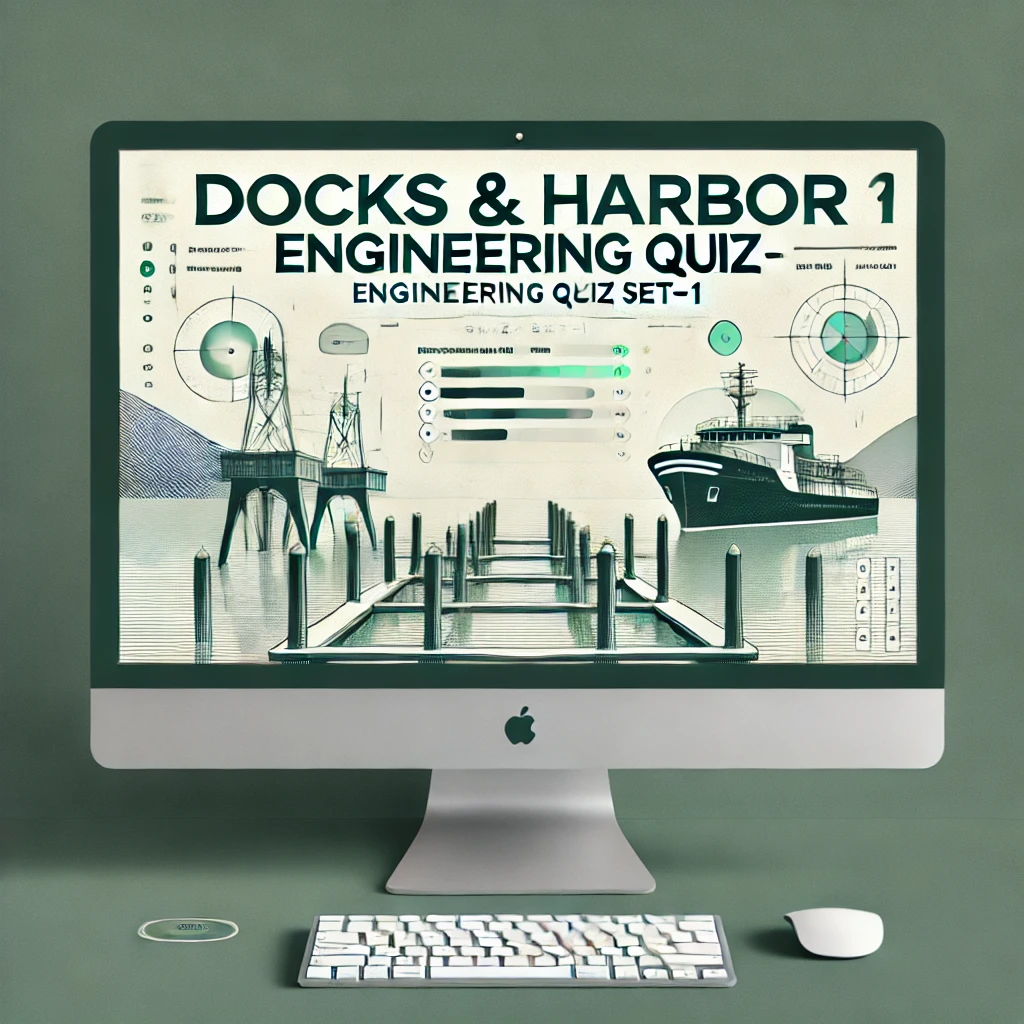Docks and Harbor Engineering Quiz Set-1 [2025]
Welcome to “Docks and Harbor Engineering Quiz Set-1 [2025]”! In this blog, we’ve curated 50+ thought-provoking multiple-choice questions covering the fundamental and advanced concepts of docks and harbor engineering. “Docks and Harbor Engineering Quiz Set-1 [2025]” is designed to help you refresh your basics, challenge your knowledge, and gain practical insights into the techniques and principles of docks and harbor construction and maintenance. Whether you’re a civil engineering student, a marine engineer, or preparing for competitive exams, this quiz is the perfect way to enhance your expertise in docks and harbor engineering. Let’s dive into the “Docks and Harbor Engineering Quiz Set-1 [2025]” and start exploring! Docks and Harbor Engineering: A Comprehensive Guide Docks and Harbor Engineering is a critical field within civil engineering that focuses on the design, construction, and maintenance of docks, harbors, and port structures. These facilities are essential for global trade, transportation, and maritime activities. This blog provides an in-depth overview of Docks and Harbor Engineering, its significance, components, and frequently asked questions. What is Docks and Harbor Engineering? Docks and Harbor Engineering involves the planning, design, and construction of infrastructure to support the safe berthing, loading, unloading, and storage of vessels and cargo. It combines principles of civil, structural, and marine engineering to ensure operational efficiency and environmental sustainability. See Also: Concrete Structures Quiz Set-1 Importance of Docks and Harbors Global Trade: Ports are the backbone of international trade, facilitating the movement of goods across continents. Economic Growth: Well-designed docks and harbors stimulate economic activity by supporting industries like shipping, logistics, and tourism. Safety: Proper engineering minimizes risks to vessels, cargo, and personnel. Environmental Impact: Sustainable harbor designs reduce environmental damage and promote marine ecosystem conservation. Key Components of Docks and Harbors Dock A dock is a structure where ships are moored for loading, unloading, or repairs. Types of Docks: Wet Dock: Enclosed by gates, maintains water levels. Dry Dock: Used for ship repairs, where water is drained. Harbor A harbor is a sheltered area of water where ships anchor safely. Types of Harbors: Natural Harbors: Formed by natural landforms like bays. Artificial Harbors: Man-made harbors created using breakwaters and dredging. Port Infrastructure Wharves and Piers: Platforms extending into the water for berthing ships. Jetties: Structures to guide water currents or moor ships. Breakwaters: Barriers to protect harbors from waves and currents. Cargo Handling Facilities: Cranes, conveyors, and storage areas. Navigation Aids Lighthouses, buoys, and beacons for guiding ships safely. See Also: Engineering Mechanics Quiz Set-1 Engineering Challenges in Docks and Harbor Construction Geotechnical Challenges Assessing soil stability for foundation design. Ensuring resistance to tidal and seismic forces. Hydrodynamic Forces Designing structures to withstand waves, currents, and storm surges. Environmental Concerns Managing dredging impacts and marine pollution. Preserving aquatic ecosystems and complying with environmental regulations. Material Durability Using materials resistant to corrosion, salinity, and weathering. Advanced Technologies in Docks and Harbor Engineering Smart Ports Integration of IoT, AI, and data analytics to improve port operations. Automated cargo handling and real-time monitoring of ship movements. Sustainable Engineering Eco-friendly breakwaters using natural materials. Renewable energy sources like wind and solar at port facilities. Dredging Innovations Advanced dredging equipment to minimize environmental disruption. Simulation and Modeling Computer simulations to predict wave behavior and optimize design. Career Opportunities in Docks and Harbor Engineering Port Engineer Responsible for maintaining and improving port infrastructure. Marine Structural Engineer Specializes in designing and constructing docks, jetties, and breakwaters. Environmental Consultant Focuses on minimizing the ecological impact of harbor projects. Geotechnical Engineer Ensures stability and safety of harbor foundations. Project Manager Oversees the planning, execution, and completion of dock and harbor projects. See Also: Steel Structures Quiz Set-1 FAQs 1. What is the difference between a dock and a harbor? A dock is a structure where ships are moored for operations like loading and unloading, while a harbor is a sheltered area of water where ships can anchor safely. 2. What are the types of docks? The main types of docks include wet docks (with gates to maintain water levels) and dry docks (used for ship repairs with drained water). 3. Why are breakwaters important in harbors? Breakwaters are barriers that protect harbors from waves and currents, ensuring safe anchorage for ships. 4. What materials are used in harbor construction? Common materials include reinforced concrete, steel, and corrosion-resistant coatings to withstand marine conditions. 5. What is the role of dredging in harbor engineering? Dredging deepens and maintains navigable waterways, ensuring ships can safely enter and exit the harbor. 6. How does technology improve port operations? Smart ports use IoT, AI, and automation to enhance efficiency, monitor ship movements, and manage cargo handling systems. 7. What are the environmental challenges in docks and harbor engineering? Key challenges include managing dredging impacts, reducing marine pollution, and protecting aquatic ecosystems. Conclusion Docks and Harbor Engineering is a vital discipline that supports maritime trade, transportation, and economic development. By leveraging innovative technologies and sustainable practices, engineers continue to design efficient and eco-friendly port infrastructures. Whether you’re a student, professional, or enthusiast, understanding the intricacies of this field opens the door to exciting career opportunities and advancements in marine infrastructure. Embark on your journey to explore more about Docks and Harbor Engineering and make waves in this dynamic domain!
